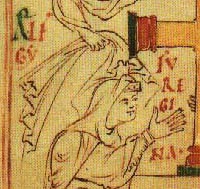March 7, 1052: Death of Lady Emma, the Queen-mother
 Emma was the daughter of Richard I, count of Rouen, and was brought up in Normandy. In 1002 she crossed to England (where she was given the Old English name Ælfgifu), and married King Æthelred (978-1016). She would be an important force in English politics for the next forty years, only really retiring after her son, Edward the Confessor, deprived her of her lands and treasures in 1043.
Emma was the daughter of Richard I, count of Rouen, and was brought up in Normandy. In 1002 she crossed to England (where she was given the Old English name Ælfgifu), and married King Æthelred (978-1016). She would be an important force in English politics for the next forty years, only really retiring after her son, Edward the Confessor, deprived her of her lands and treasures in 1043.
Perhaps the most remarkable fact in Emma's career is that in 1017, the year after Æthelred died and the Danish king Cnut took over England, Cnut summoned Emma and married her himself. This adroit move would have been to the benefit of all concerned: Cnut, the Viking invader, gains legitimacy by such close connection with the previous English royalty, and his recognition of Emma probably heads off Norman intervention on behalf of Emma's sons by Æthelred (Alfred and Edward the Confessor) growing up at the Norman court. Emma gets a renewed lease of power, and her time with Cnut seems to be a high point in the prestige and power of the queen in Anglo-Saxon England.
On Cnut's death in 1035, Emma was an important player in the manoeuvrings between Harthacnut, her son by Cnut, and another claimant to the throne, Harold Harefoot. Harold triumphed at first, but on his death in 1040 Emma returned with her son Harthacnut. At about this time she commissioned the Encomium Emma Reginae, though this is rather more political propaganda for the regimes of Cnut and Harthacnut than praise of the queen herself.
Review the history, 1002-52.
Manuscript images:
Queen Emma and King Cnut present a gold cross to the New Minster, Winchester (from the New Minster Liber Vitae)
Queen Emma, with her sons Edward and Harthacnut, being presented the Encomium Emmae Reginae (from the Encomium Emmae)